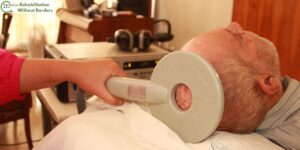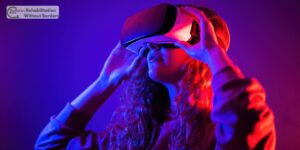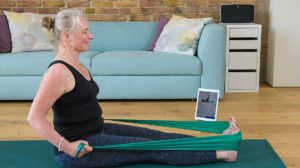Scientific Knowledge
Physical Disabilities

Scientific Evidence of Telerehabilitation
Are you tired of playing “traffic dodgeball” just to get to your physical therapy appointments? What if we told you that cutting-edge science proves you can achieve the same, or even better, recovery results right from your living room? This comprehensive article dives deep into the rigorous scientific evidence—including meta-analyses and randomized controlled trials—that validates telerehabilitation as a highly effective, cost-efficient, and accessible alternative to traditional in-clinic care. We will explore how remote therapeutic monitoring is revolutionizing recovery for orthopedic, cardiac, and neurological conditions, paving the way for platforms like TeleWeCure to bring the future of healthcare directly to you.

Repetitive Transcranial Magnetic Stimulation (rTMS): A Glimmer of Hope in Stroke Rehabilitation
Stroke is a leading cause of long-term disability worldwide. While traditional rehabilitation is crucial, emerging technologies are offering new avenues for recovery. Repetitive Transcranial Magnetic Stimulation (rTMS) is one such non-invasive brain stimulation technique that shows significant promise in enhancing motor, cognitive, and speech recovery after a stroke. This article provides a comprehensive overview of how rTMS works, its clinical effects, and how telerehabilitation, exemplified by the pioneer platform TeleWeCure, is making this innovative treatment more accessible.

Virtual Reality and Augmented Reality: Immersive Therapies for Neurological Conditions
Imagine a world where your physical therapy session feels less like a clinic visit and more like a video game. For some people recovering from a stroke, brain injury, or other neurological conditions, this isn’t science fiction—it’s the new reality of rehabilitation. This article will explore the incredible therapeutic power of Virtual Reality (VR) and Augmented Reality (AR), examining how these immersive technologies are transforming the journey to recovery. We’ll delve into the science behind the magic, discover how these tools are helping patients regain lost function, and see why the future of neurological care is now more engaging than ever.
Tele-Rehabilitation

Scientific Evidence of Telerehabilitation
Are you tired of playing “traffic dodgeball” just to get to your physical therapy appointments? What if we told you that cutting-edge science proves you can achieve the same, or even better, recovery results right from your living room? This comprehensive article dives deep into the rigorous scientific evidence—including meta-analyses and randomized controlled trials—that validates telerehabilitation as a highly effective, cost-efficient, and accessible alternative to traditional in-clinic care. We will explore how remote therapeutic monitoring is revolutionizing recovery for orthopedic, cardiac, and neurological conditions, paving the way for platforms like TeleWeCure to bring the future of healthcare directly to you.

Repetitive Transcranial Magnetic Stimulation (rTMS): A Glimmer of Hope in Stroke Rehabilitation
Stroke is a leading cause of long-term disability worldwide. While traditional rehabilitation is crucial, emerging technologies are offering new avenues for recovery. Repetitive Transcranial Magnetic Stimulation (rTMS) is one such non-invasive brain stimulation technique that shows significant promise in enhancing motor, cognitive, and speech recovery after a stroke. This article provides a comprehensive overview of how rTMS works, its clinical effects, and how telerehabilitation, exemplified by the pioneer platform TeleWeCure, is making this innovative treatment more accessible.

Virtual Reality and Augmented Reality: Immersive Therapies for Neurological Conditions
Imagine a world where your physical therapy session feels less like a clinic visit and more like a video game. For some people recovering from a stroke, brain injury, or other neurological conditions, this isn’t science fiction—it’s the new reality of rehabilitation. This article will explore the incredible therapeutic power of Virtual Reality (VR) and Augmented Reality (AR), examining how these immersive technologies are transforming the journey to recovery. We’ll delve into the science behind the magic, discover how these tools are helping patients regain lost function, and see why the future of neurological care is now more engaging than ever.

The Rise of AI in Personalized Rehabilitation Programs
: Artificial intelligence is rapidly revolutionizing the field of rehabilitation, offering more personalized and effective treatment plans. This article explores the growing role of AI in the design, implementation, and monitoring of rehabilitation.

Virtual Physical Therapy
Ever wished you could skip the commute and still get top-notch physical therapy? Good news! Virtual Physical Therapy for musculoskeletal issues is making that dream a reality. Discover how this innovative approach, powered by platforms like TeleWeCure, brings expert care right to your living room, helping you bounce back faster and stronger.

What is TeleRehabilitation
Discover the transformative power of telerehabilitation — a cutting-edge approach to delivering physiotherapy, speech therapy, and rehabilitation services remotely. Perfect for stroke survivors, multiple sclerosis patients, and those with brain injuries, telerehabilitation offers convenient, effective, and personalized care right from the comfort of your home.
Pain Disorders

Conquering Chronic Low Back Pain: A Guide to Rehabilitation and Telerehabilitation
Chronic low back pain is a global epidemic, affecting millions and limiting daily activities. While traditional rehabilitation has long been a cornerstone of treatment, new advancements in telerehabilitation are making expert care more accessible and convenient than ever before. This comprehensive guide will explore the causes and effective management strategies for chronic low back pain, and introduce you to TeleWeCure, a pioneering platform that brings professional rehabilitation right to your screen. Get ready to finally tell your back pain to take a hike (in a way that won’t make it worse, of course!).
Advancements in Rehabilitation

Scientific Evidence of Telerehabilitation
Are you tired of playing “traffic dodgeball” just to get to your physical therapy appointments? What if we told you that cutting-edge science proves you can achieve the same, or even better, recovery results right from your living room? This comprehensive article dives deep into the rigorous scientific evidence—including meta-analyses and randomized controlled trials—that validates telerehabilitation as a highly effective, cost-efficient, and accessible alternative to traditional in-clinic care. We will explore how remote therapeutic monitoring is revolutionizing recovery for orthopedic, cardiac, and neurological conditions, paving the way for platforms like TeleWeCure to bring the future of healthcare directly to you.

Repetitive Transcranial Magnetic Stimulation (rTMS): A Glimmer of Hope in Stroke Rehabilitation
Stroke is a leading cause of long-term disability worldwide. While traditional rehabilitation is crucial, emerging technologies are offering new avenues for recovery. Repetitive Transcranial Magnetic Stimulation (rTMS) is one such non-invasive brain stimulation technique that shows significant promise in enhancing motor, cognitive, and speech recovery after a stroke. This article provides a comprehensive overview of how rTMS works, its clinical effects, and how telerehabilitation, exemplified by the pioneer platform TeleWeCure, is making this innovative treatment more accessible.

Virtual Reality and Augmented Reality: Immersive Therapies for Neurological Conditions
Imagine a world where your physical therapy session feels less like a clinic visit and more like a video game. For some people recovering from a stroke, brain injury, or other neurological conditions, this isn’t science fiction—it’s the new reality of rehabilitation. This article will explore the incredible therapeutic power of Virtual Reality (VR) and Augmented Reality (AR), examining how these immersive technologies are transforming the journey to recovery. We’ll delve into the science behind the magic, discover how these tools are helping patients regain lost function, and see why the future of neurological care is now more engaging than ever.

The Rise of AI in Personalized Rehabilitation Programs
: Artificial intelligence is rapidly revolutionizing the field of rehabilitation, offering more personalized and effective treatment plans. This article explores the growing role of AI in the design, implementation, and monitoring of rehabilitation.
